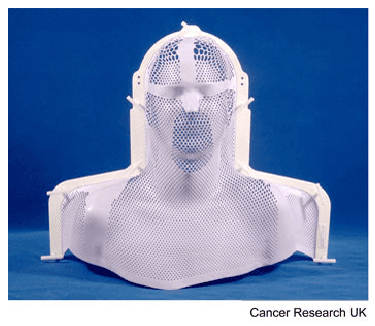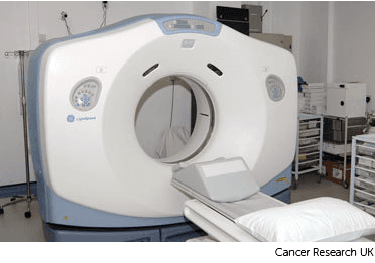Radiotherapy
You might need to have a radiotherapy mask or mould made before you start treatment. They can also be called shells. They keep the treatment area of your body still each time you have your radiotherapy. This is so your treatment is as accurate as possible.
Your radiographers may make marks on it. They use the marks to line up the radiotherapy machine for each treatment.
The process of making the shell can vary slightly between hospitals. It usually takes around 30 minutes.

You need to wear clothes that you can easily take off from your neck and chest. You also need to take off any jewellery from that area.
Facial hair, long hair or dreadlocks can make it difficult to mould the shell. Your specialist cancer nurse or radiotherapy team will tell you if you need to shave or tie your hair back.
A technician uses a special kind of plastic mesh that they heat in warm water. This makes it soft and pliable. They put the plastic on to your face, neck and chest so that it moulds exactly.
After a few minutes the plastic gets hard. The technician takes the shell off and it is ready to use.
The video below shows what happens when you have a mesh mask made. For head and neck cancer, the mask covers your neck and the tops of your shoulders as well as your head.
The radiotherapy team plan your external radiotherapy before you start treatment. This means working out the dose of radiotherapy you need and exactly where you need it.
Your planning appointment takes from 15 minutes to 2 hours.
You usually have a planning CT scan in the radiotherapy department.
The scan shows the cancer and the area around it. You might have other types of scans or x-rays to help your treatment team plan your radiotherapy. The plan they create is just for you.

Your radiographers tell you what is going to happen. They help you into position on the scan couch.
The CT scanner couch is the same type of bed that you lie on for your treatment sessions. You need to lie very still during the scan. You might also have a type of firm cushion called a vacbag to help you keep still. Tell your radiographers if you aren't comfortable.
Once you are in position on the scanner couch your radiographers move it up and through the scanner. They then leave the room and the scan starts.
The scan takes about 5 minutes. You won't feel anything. Your radiographers watch from the room next door and you can talk to them on an intercom if you need to.
Your treatment team puts all the scans together in a special computer to decide your radiotherapy plan.
You might have to wait a few days or up to 3 weeks before you start treatment.
During this time the physicists and your radiotherapy doctor (clinical oncologist) decide the final details of your radiotherapy plan. They make sure that the area of the cancer will receive a high dose and nearby areas receive a low dose. This reduces the side effects you might get during and after treatment.
Find out about having external radiotherapy for nasopharyngeal cancer
Last reviewed: 30 Apr 2024
Next review due: 30 Apr 2027
Your radiotherapy treatment plan is individual to you. You have a CT scan or MRI scan, to create your radiotherapy plan.
With external radiotherapy, a large machine aims the radiation beams at the cancer. You go to the hospital for treatment once a day, from Monday to Friday, with a break at the weekends. The length of the course of treatment varies but it is usually between 5 and 7 weeks.
Most people have side effects from radiotherapy to the nasopharynx. These include sore skin in the treatment area, a sore mouth and throat, dry mouth and taste changes. These are usually short term but there is a risk of late side effects.
Chemotherapy combined with radiotherapy is called chemoradiotherapy. You might have it as a treatment for nasopharyngeal cancer.
Radiotherapy is one of the main treatments for nasopharyngeal cancer. The treatment you have depends on several things, including where the cancer is, its size, whether it has spread (the stage) and your general health.

About Cancer generously supported by Dangoor Education since 2010. Learn more about Dangoor Education
Search our clinical trials database for all cancer trials and studies recruiting in the UK.
Connect with other people affected by cancer and share your experiences.
Questions about cancer? Call freephone 0808 800 40 40 from 9 to 5 - Monday to Friday. Alternatively, you can email us.